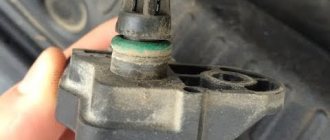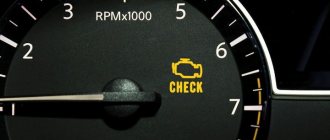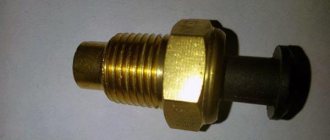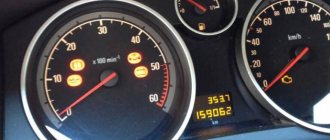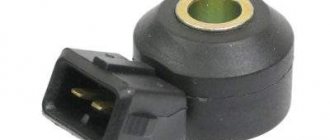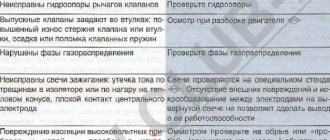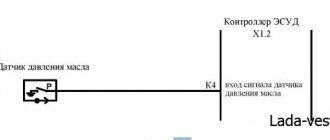It is unlikely that any motorist will be happy with the fact that the Check Engine light comes on on the dashboard. Often this does not bode well.
Yes, sometimes false alarms occur, and in reality there is no malfunction. But in most cases there are problems. They can be determined by the characteristic behavior of the car, as well as by reading error codes recorded and stored in the memory of the control unit.
It is enough to connect to the ECU with a diagnostic scanner or use a smartphone to connect to the unit. A universal error coding scheme allows you to understand what kind of malfunction we are talking about or at least in which of the many systems to look for it.
One of the unpleasant errors is considered to be code P0300. The motorist should know what it means, what caused it and how to fix it.
What does error P0300 mean?
The code in question is directly related to malfunctions on the part of the ignition system.
Error P0300 indicates the presence of misfires in the ignition system, that is, the ignition order is disrupted.
Also, such a malfunction can be described as random multiple misfires that were detected in the ignition system. This is if we take the translation of the English message as a basis. A literal translation yields a similar explanation. This problem is expressed in the form of code P0300 when scanning the memory of the control unit.
If multiple random leaks are detected in the system, the air-fuel mixture ignition system will not be able to function normally. The P0300 error that appears indicates this, helping the driver roughly understand what to look for and in which area to look for a fault.
Error P0300 on some cars varies from 0300 to 0312.
This is due to the fact that certain electronic control units can independently detect in which specific cylinder misfires are recorded. Depending on the final digit in the error code, the motorist understands which cylinder should be entered.
For example, if the engine has 6 cylinders, then the error will vary from 0300 to 0306. If code 0305 appears, then the problem is, accordingly, in the fifth cylinder.
But keep in mind that not all computers determine the exact location of the malfunction, and therefore the diagnostic scanner screen may simply display code P0300. Then, through additional checks, you will have to determine which of the cylinders has leaks.
How to replace a spark plug?
Replacing the spark plug is a simple task and you can do it at home. Before changing spark plugs, make sure the engine temperature is low.
Step 1: Open the hood and locate the spark plug
Open the hood and you will see several wires running in the engine compartment. The spark plugs are located in the engine at the end of these wires.
Step 2: Pull the wire
Pull the wire and you will see the spark plug installed.
Step 3: Remove the candle
Insert the spark plug wrench and turn to loosen the spark plug. Remove the old spark plug and note its condition.
Step 4. Install a new spark plug
Using the same spark plug wrench, install the new spark plug and tighten it correctly. Then connect the wire as it was before. All is ready.
Conditions for generating an error
In order for error P0300 to be ultimately recorded by the control unit and stored in memory, certain conditions must be met.
- The system must detect the presence of misfires simultaneously in several working cylinders of the engine.
- When idling, the error is recorded in the memory 210 seconds after the engine starts.
- If the speed is 2000 rpm and higher, then the error will persist after 60 seconds.
- To fix P0300 in the ECU memory, it is required that the omission be more than 3.25% of the number of flashes that occur per 1 thousand crankshaft revolutions.
When misfires occur in the engine, the exhaust toxicity in the exhaust system pipe increases significantly.
This problem can cause an increase in the temperature of the catalyst and its further damage in the form of melting of the honeycomb. And replacing a catalyst is very expensive, even on budget cars.
On some cars, in order to reduce fuel burnout in the catalyst and reduce toxicity, the ECU monitors misfires based on data from the camshaft and crankshaft. In addition to registering an error and the appearance of the Check Engine indicator on the instrument panel, the electronics can turn off some injectors in the cylinders where misfires are observed.
Other automaker definitions for P1602
DTC P1602 is considered a vehicle manufacturer specific code. Brands like Volkswagen and Audi refer to it as "Engine Control Module - Low Battery Voltage" or "Power Supply Terminal 30 (B+) Low Voltage." This malfunction occurs when the transmission control determines that the battery current supplied when the ignition is off does not reach the minimum permissible threshold.
Various motor control modules are a complex computer, which includes a large number of voltage regulators and stabilizers, current converters, driver circuits and several types of memory.
Certain functions, such as fault memory, basic idle speed settings, basic ignition timing settings and some others, depend on the memory functions. If the power supply to these circuits is interrupted, malfunctions related to these functions may occur. In fact, these circuits remain turned on even when the ignition is off to ensure that the engine starts and runs smoothly.
The set of functions of these functions is also known as KAM. The PCM is supplied with the most important operating instructions via the KAM memory. With their help, it starts running and can be used until the PCM activates inputs or sensor feedback loops to keep the engine running.
From the above it should be clear that if the KAM memory was lost due to a lack of or stopped power, the critical operating elements that the PCM requires to "boot" will be out of reach and the engine may eventually be shut down. However, when the PCM detects insufficient power to the Keep Alive Memory, it will set a P1602 code and the warning light may also come on.
Characteristic symptoms
Even inexperienced motorists can predict in advance the display of error code P0300 on the scanner, based on changes in the behavior of their vehicle.
There are several signs characteristic of such an error:
- at idle speed the engine vibrates noticeably;
- similar shaking occurs at low speeds;
- when picking up speed, the car can jerk and throw to the sides;
- fuel consumption increases significantly;
- problems in the form of difficulty starting the engine cannot be ruled out;
- traction drops, dynamics deteriorate, the car fails to accelerate normally.
All this is accompanied by a lit Check Engine light on the dashboard.
Having noticed such signs, it is almost certain that there is a misfire. That is, when connected to the computer with a diagnostic scanner, the code P0300 will be displayed in the memory.
When P0118 is output, clearing the controller memory from it
Sensor signal error P0118 (its code) appears in the ECU controller memory under the following conditions (generalized, there may be differences for some brands):
- The internal combustion engine runs from 120 seconds;
- 0.2 sec. voltage from the detector as at t° below -42 or -38 (may vary slightly for different vehicles);
- if the malfunction is persistent after 2 drive cycles, then CHECK ENGINE is displayed.
We summarize the conditions under which the code is deleted from the ECU controller (the memory is cleared):
- CHECK ENGINE disappears (turns off) if the control system does not detect a malfunction after 4 cycles of starting the engine;
- The diagnostic history becomes clear after 40 consecutive heating cycles of antifreeze in the absence of a problem.
Causes
Error P0300 does not appear by itself. There must be appropriate reasons for this.
Misfires are possible in situations where it is not possible to ignite the air-fuel mixture or there is simply nothing to ignite.
Based on this, there are several main reasons for the occurrence of error P0300.
- Faulty power system. The point is that low quality fuel is supplied to the cylinders or there is not enough fuel for normal operation. This is usually due to a dirty filter, low pressure in the fuel line, carbon deposits and contamination on the injectors.
- Problems on the ignition side. There are many elements here that could potentially fail. These are all those components that take part in the processes of igniting the mixture of fuel and air. But most often, a broken high-voltage wire, a dirty or faulty spark plug, a broken coil or ignition module are discovered. Additionally, you can suspect faulty contacts or a violation of the integrity of the wiring.
- Damage to the intake and exhaust system. If error P0300 appears precisely because of problems in this system, then first check the catalyst for clogging. In the vast majority of cases, he is to blame. But it is also possible that there may be air leaks, valve malfunction, low compression, or problems with the timing (gas distribution mechanism).
- Failure of electronic components. There are several sensors, in the absence of signals from which error P0300 can appear. These include crankshaft, knock, camshaft and intake air temperature sensors. The last thing you can suspect is a faulty control unit. But the ECU fails extremely rarely, and its repair is carried out only with professional intervention.
If the scanner shows errors in a specific cylinder, that is, a code like P0301, P0302 or P0304 is displayed, for example, then the reason should be looked for in the ignition system.
When the ECU cannot report problems in a specific cylinder and simply generates an error code P0300, then a more in-depth diagnosis will be required, eliminating all potential causes of its occurrence.
On which cars is this problem most common?
The problem with the P0300 code can occur on different machines, but there are always statistics on which brands this error occurs more often. Here is a list of some of them:
- Alfa Romeo
- Audi (Audi a4, Audi a6, Audi q7)
- BMW (BMW X5, E39, E46)
- Cadillac (Cadillac SRX, Escalade)
- Chery (Chery Tiggo, QQ6)
- Chevrolet (Chevrolet Aveo, Captiva, Cobalt, Cruz, Lanos, Lacetti, Rezzo, Silverado, Spark, Tahoe, Trailblazer)
- Chrysler (Chrysler Voyager, Intrepid, Pacifica, Town Country, 300c)
- Citroen (Citroen C5)
- Daewoo (Daewoo Matiz, Nexia)
- Dodge (Dodge Intrepid, Caliber, Caravan, Neon)
- Fiat (Fiat Albea, Doblo, Punto)
- Ford (Ford Mondeo, Ranger, Focus, Fusion, Explorer, C-Max, F-150)
- Geely (Geely MK, MK Cross)
- GMC Safari
- Great Wall Hover
- Honda (Honda Accord, Civic)
- Hover (Hover H3, Hover H5)
- Hummer H3
- Hyundai (Hyundai Accent, Getz, Matrix, H1, Santa Fe, Solaris, Sonata, Tucson, Elantra, i30)
- Infiniti (Infiniti fx35, g35, qx56)
- Isuzu
- Jaguar (Jaguar S-Type)
- Jeep (Jeep Grand Cherokee, Commander, Liberty)
- Kia (Kia Picanto, Rio, Sid, Sorento, Spectra, Sportage, Cerato)
- Lexus (Lexus gs300, gx470, lx470, is250, rx300, rx350)
- Lifan (Lifan Solano)
- Mazda (Mazda 3, Mazda 5, Mazda 6, Mazda cx7, Millenia, Protege, MPV)
- Mercedes (Mercedes s500, w166, w220)
- Mitsubishi (Mitsubishi Outlander, Galant, Karizma, Lancer, Montero, Pajero, Space Star)
- Nissan (Nissan Almera, Qashqai, Maxima, Murano, Note, Patrol, Primera, Teana, Tiida, X-Trail)
- Opel (Opel Agila, Antara, Astra, Vectra, Zafira, Insignia, Corsa, Meriva, Mocha)
- Peugeot (Peugeot 206, 307, 308, 406, 407, 607)
- Pontiac (Pontiac Montana)
- Porsche (Porsche Cayenne)
- Renault (Renault Duster, Kangu, Clio, Logan, Megan, Sandero, Simbol)
- Saab 9-3
- Skoda (Skoda Yeti, Octavia, Superb)
- Ssangyong (Sangyong Kyron)
- Subaru
- Suzuki (Suzuki Vitara, Grand Vitara)
- Toyota (Toyota Camry, Corolla, Matrix, Prius, Rav4, Celica, Highlander)
- Volkswagen (Volkswagen Amarok, Golf, Jetta, Passat, Polo Sedan, Touareg, Touran, Tiguan)
- Volvo (Volvo s40, s60, s80, xc90)
- Vortex
- VAZ 2105, 2107, 2110, 2111, 2112, 2113, 2114, 2115
- Volga Cyber
- Gazelle Business, Chrysler
- Lada Vesta, Granta, Kalina, Largus, Niva, Priora
- TagAZ Tager
- UAZ Bukhanka, Patriot, Hunter, 409
You can sometimes encounter other errors with the P0300 fault code. The most common are: P0021, P0100, P0101, P0102, P0131, P0133, P0135, P0151, P0170, P0171, P0172, P0174, P0201, P0202, P0301, P0302, P0303, P0304, P0305, P030 6, P0308, P0340, P0341 , P0363, P0404, P0420, P0422, P1297, P1303, P1336, P1396, P1682.
Diagnostics and repair
By carrying out diagnostic measures, you can detect malfunctions and understand why exactly the P0300 error code appeared.
Experts advise adhering to this sequence.
- Check the condition of high-voltage wires. You will need a multimeter set to resistance measurement mode. If the insulation is intact, the resistance will be from 4 to 10 kOhm.
- Check the ignition module or coils. A stand or multimeter will help here. The easiest way to test is by mounting the coil on a properly functioning cylinder. After this, the engine starts and the code is read into the ECU again. If the code has not changed, then the coil is working. We are looking for the reason further.
- Test the spark plugs. They should be dismantled and inspected for carbon deposits and damage. If necessary, cleaning is performed and the gap is set. If the spark plug fails, it should be replaced.
- Compression in cylinders. If it is low or there is no compression, this provokes difficulties with ignition. If compression is normal, move on.
- Injector condition. You can’t do without a diagnostic stand here. One of the options without involving a service station would be to refuel with high-octane gasoline. You need to drive it for 10-20 km at high speeds, and then check the error again.
- Check the fuel filter. This is a consumable that changes periodically. If the filter is dirty or bad fuel is used, the injectors become clogged and misfires occur. Hence P0300.
- Inspect the condition of the gasket on the intake manifold. Sometimes, due to its wear, gaps form and the error in question appears. The gasket should be replaced.
- It would be a good idea to check the EGR valve. It can jam, which leads to the problems in question. To do this, long-term fuel correction is checked in specific suspect cylinders. Differences from optimal indicators should be no more than 1-3%. You can easily find out about the reference values from the manual. With deviations of more than 7%, excess air intake occurs. The valve should be repaired or replaced.
Not all problems can be solved on our own. But it is absolutely impossible to ignore the symptoms that appear with P0300.
Codes related to P0132
- P0130 - Oxygen sensor circuit (bank 1, sensor 1).
- P0131 - O2 Sensor Circuit Low Voltage (Bank 1 Sensor 1).
- P0132 - O2 Sensor Circuit High Voltage (Bank 1, Sensor 1).
- P0136 - O2 sensor circuit failure (bank 1, sensor 2).
- P0137 - O2 Sensor Circuit Low Voltage (Bank 1 Sensor 2).
- P0138 - O2 Sensor Circuit High Voltage (Bank 1 Sensor 2).
- P0150 - O2 Sensor Circuit (Bank 2 Sensor 1).
- P0151 - O2 Sensor Circuit Low Voltage (Bank 2 Sensor 1).
- P0152 - O2 Sensor Circuit High Voltage (Bank 2 Sensor 1).
- P0156 - O2 Sensor Circuit Malfunction (Bank 2 Sensor 2).
- P0157 - O2 Sensor Circuit Low Voltage (Bank 2 Sensor 2).
- P0158 - O2 Sensor Circuit High Voltage (Bank 2 Sensor 2).
Verification methods
Recommended verification algorithm:
- Disconnect the connector, analyze the condition, and inspect it. Sometimes high temperatures and age cause fasteners to crumble, which causes poor contact. It is necessary to inspect the fastening features. For example, on the body of the VAZ 2114 coolant temperature sensor there is a fixing ear; it can break off, the connection will deteriorate, and dirt can get through the gap.
- Use a multimeter to check whether the sensor receives 5 V from the control system. You can do this without starting the engine, just turn on the ignition.
- Check the cleanliness of the contacts and clean them with cleaner.
- Dismantling and visual analysis of the entire device. Checking with a multimeter:
- Continuity of wiring, they can be replaced. Before disconnecting, it is advisable to remember the pinout (contact numbers) on the ECU; it is also indicated in the manual. Measure the resistance between the wires (ohmmeter mode), which will show the state of the insulation, that is, whether there is a short circuit. An indicator close to zero means short circuit. You need to find the location of the breakdown, insulate the cores along their entire length with electrical tape, or better yet, with heat shrink; the ideal option is to replace them completely.
- In the same mode as in the previous paragraph, analyze the resistance, but between each wire and ground. A value close to zero means a short to body. The solution is similar to the above - replacement.
Caution: there is a risk of making a mistake and replacing the working sensor if the reason lies in the wiring (break or short circuit). Upon completion of the repair, it is imperative to clear the ECU’s error memory, otherwise the data will trigger an error code until the end of the full cycle included in the program’s update algorithm.
